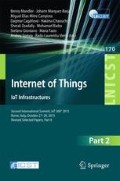Abstract
The Dynamic Embedded Sensor-Actuator Language (DESAL) [2] is a rule-based programming language, without events, interrupts, or hidden control. Nodes have built-in access to their neighbors’ state, with automatic node discovery and health monitoring. Applications communicate via shared variables, rather than explicit message passing. Shared variables naturally represent the state of self-stabilizing algorithms. DESAL simplifies the construction of self-stabilizing embedded applications by eliminating network programming, while offering significant reliability improvements.
Access this chapter
Tax calculation will be finalised at checkout
Purchases are for personal use only
References
Dalton, A.R., et al.: \(Desal^\alpha \) : an implementation of the dynamic embedded sensor-actuator language. In: Proceedings of the ICCCN 2008, vol. 8 (2008)
Arora, A., et al.: A state-based language for sensor-actuator networks. ACM SIGBED Rev. 4(3), 25–30 (2007)
Hill, J., et al.: System architecture directions for networked sensors. In: Proceedings of the ASPLOS IX, pp. 93–104 (2000)
Dunkels, A., et al.: Contiki - a lightweight and flexible operating system for tiny networked sensors. In: Proceedings of the LCN 2004, pp. 455–462, November 2004
Bhatti, S., et al.: Mantis OS: an embedded multithreaded operating system for wireless micro sensor platforms. Mob. Netw. Appl. 10(4), 563–579 (2005)
Gay, D., et al.: The nesC language: a holistic approach to networked embedded systems. In: Proceedings of the PLDI 2003, pp. 1–11 (2003)
Madden, S.R., et al.: TinyDB: an acquisitional query processing system for sensor networks. ACM Trans. Database Syst. 30(1), 122–173 (2005)
Yao, Y., Gehrke, J.: The cougar approach to in-network query processing in sensor networks. SIGMOD Rec. 31(3), 9–18 (2002)
Gummadi, R., Gnawali, O., Govindan, R.: Macro-programming wireless sensor networks using Kairos. In: Prasanna, V.K., Iyengar, S.S., Spirakis, P.G., Welsh, M. (eds.) DCOSS 2005. LNCS, vol. 3560, pp. 126–140. Springer, Heidelberg (2005)
Newton, R., et al.: The regiment macroprogramming system. In: Proceedings of the IPSN 2007, pp. 489–498. ACM, New York (2007)
Weyer, C., Turau, V.: SelfWISE: a framework for developing self-stabilizing algorithms. In: David, K., Geihs, K. (eds.) Kommunikation in Verteilten Systemen (KiVS), pp. 67–78. Springer, Heidelberg (2009)
Osterlind, F., et al.: Cross-level sensor network simulation with COOJA. In: Proceedings of the LCN 2006, pp. 641–648, November 2006
NESCC. linux.die.net/man/1/nescc
Dalton, A., et al.: A testbed for visualizing sensornet behavior. In: Proceedings of the ICCCN 2008, pp. 1–7, August 2008
Maróti, M., et al.: The flooding time synchronization protocol. In: Proceedings of the SenSys 2004, pp. 39–49. ACM (2004)
McPeak, S., Necula, G.C.: Elkhound: a fast, practical GLR parser generator. In: Duesterwald, E. (ed.) CC 2004. LNCS, vol. 2985, pp. 73–88. Springer, Heidelberg (2004)
Hedetniemi, S.M., et al.: Self-stabilizing algorithms for minimal dominating sets and maximal independent sets. Comput. Math. Appl. 46(5–6), 805–811 (2003)
Goddard, W., et al.: Self-stabilizing protocols for maximal matching and maximal independent sets for ad hoc networks. In: Proceedings of the IPDPS 2003, p. 14. IEEE (2003)
Mahafzah, M.H.: An efficient graph-coloring algorithm for processor allocation. Int. J. Comput. Inf. Technol. 02(1) (2013)
Johnson, D.S., Garey, M.R.: Computers and Intractability. Freeman, New York (1979)
Hedetniemi, S.T., et al.: Linear time self-stabilizaing colorings. Inf. Process. Lett. 87, 251–255 (2003)
Moteiv. Tmote sky (2005). http://www.eecs.harvard.edu/~konrad/projects/shimmer/references/tmote-sky-datasheet.pdf
Levis, P.: Experiences from a decade of tinyos development. In: Proceedings of the OSDI 2012, pp. 207–220. USENIX, Berkeley (2012)
Acknowledgment
This work is supported by the NSF through award CNS-0746632.
Author information
Authors and Affiliations
Corresponding author
Editor information
Editors and Affiliations
Rights and permissions
Copyright information
© 2016 ICST Institute for Computer Sciences, Social Informatics and Telecommunications Engineering
About this paper
Cite this paper
He, Y., Du, Y., Hughes, S., Zhai, J., Hallstrom, J.O., Sridhar, N. (2016). DESAL\(^\beta \): A Framework For Implementing Self-stabilizing Embedded Network Applications. In: Mandler, B., et al. Internet of Things. IoT Infrastructures. IoT360 2015. Lecture Notes of the Institute for Computer Sciences, Social Informatics and Telecommunications Engineering, vol 170. Springer, Cham. https://doi.org/10.1007/978-3-319-47075-7_34
Download citation
DOI: https://doi.org/10.1007/978-3-319-47075-7_34
Published:
Publisher Name: Springer, Cham
Print ISBN: 978-3-319-47074-0
Online ISBN: 978-3-319-47075-7
eBook Packages: Computer ScienceComputer Science (R0)

